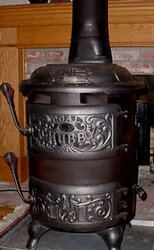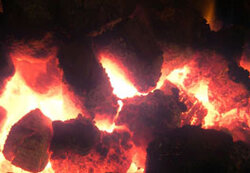In certain parts of the country, coal is popular as a home heating fuel. Coal comes in different grades, the best grade for home heating being “hard coal” or anthracite, of which the best varieties are mined in Eastern Pennsylvania. Most of the coal appliances on the market are designed to burn this high grade coal, which sells for $150. to $250. per ton. Because coal is a dense and powerful fuel, and burns extremely efficient, this ton of coal can produce as much or more heat than a cord of wood and substantially more (almost twice as much) as a ton of Pellets.
Typical Coal Stove or Insert
Coal stoves are quite similar to their wood burning cousins. Most use natural draft (don’t need electric or a fan assist for combustion), and have the same chimney requirements as wood stoves. In the past, many stoves were designed to burn both coal and wood. This type of stove is rare now, as the EPA standards have forced manufacturers to “tune” their stoves for one fuel or the other.
All Coal Stoves must have grates and an ashpan or ash removal area. Coal produces 10 times as much ash per pound as wood does, so a large ashpan is a good feature. For coal to burn properly the combustion air must enter below the grates and come up through the coal bed. Most natural draft coal stove use a medium to larger size coal (Chestnut size).

Typical Coal Stove
Learning to ignite and burn anthracite coal can be frustrating and patience is surely a virtue. If you have not had previous experience, please read the document Coaltips before you attempt starting your first coal fire. This document was created after we heard the same questions hundreds of times over. If you read it carefully and follow it to the letter, you’ll be an expert in no time.
Stoker-Feed Coal Stove
Some coal stoves, both central heating and freestanding, use a stoker feed mechanism to automatically feed coal and remove the ash from the firepot. These stokers usually use a smaller sizr coal (rice or buckwheat size) and use timers and thermostats to control the coal fire.
Chimney Concerns
Coal burns very efficiently, so the temperature going up the chimney is not as great as it is with wood. However, coal contains sulfur and other compounds which can cause corrosion, especially in stainless steel chimneys. Be sure to select a quality brand of Chimney and confirm that the warranty covers use with coal. Also be sure to clean the chimney every spring (some sweeps pour baking soda down to neutralize the acids), as most corrosion occurs over the humid summer months.
Coal Storage
Coal is waterproof and also does no attact insects. It can be stored outside in bins, in a garage or utility area or even in a basement. Many coal stove owners build wooden bins in their basements which allow the coal to be loaded in through a window.
More advantages and disadvantages
Coal has a longer burn time than wood, and can often hold for as much as 24 hours in a hand-fed stove. Automatic stokers can burn even longer at low settings. Coal is harder to start than wood or pellets, but once a fire is underway it is easy to keep it going. Because of the difficulty of starting, most coal stoves are run full time once started. For less frequent use, pellets, gas or wood might be a better fuel choice.

A Coal Fire
Most Anthracite coal is mined in eastern Pennsylvania. You can see a map showing deposits of Anthracite here. In general, the further you are located from the mines, the higher the price you will pay for hard coal (Anthracite).
Hard coal is clean burning and produces no visible smoke. The fuel value is mostly fixed carbon, which means the heat is largely in the radiant bed of glowing embers.
More information on Anthracite coal can be found at the Wikipedia Article.
Coal Size Classifications
Chestnut below 1-1/2 inch above 7/8 inch
Pea less than 7/8 more than 9/16 “
Buckwheat less than 9/16 more than 3/8 “
Rice less than 3/8 more than 3/16 “
Barley less than 3/16 more than 3/3
Typical Coal Stove or Insert
Coal stoves are quite similar to their wood burning cousins. Most use natural draft (don’t need electric or a fan assist for combustion), and have the same chimney requirements as wood stoves. In the past, many stoves were designed to burn both coal and wood. This type of stove is rare now, as the EPA standards have forced manufacturers to “tune” their stoves for one fuel or the other.
All Coal Stoves must have grates and an ashpan or ash removal area. Coal produces 10 times as much ash per pound as wood does, so a large ashpan is a good feature. For coal to burn properly the combustion air must enter below the grates and come up through the coal bed. Most natural draft coal stove use a medium to larger size coal (Chestnut size).

Typical Coal Stove
Learning to ignite and burn anthracite coal can be frustrating and patience is surely a virtue. If you have not had previous experience, please read the document Coaltips before you attempt starting your first coal fire. This document was created after we heard the same questions hundreds of times over. If you read it carefully and follow it to the letter, you’ll be an expert in no time.
Stoker-Feed Coal Stove
Some coal stoves, both central heating and freestanding, use a stoker feed mechanism to automatically feed coal and remove the ash from the firepot. These stokers usually use a smaller sizr coal (rice or buckwheat size) and use timers and thermostats to control the coal fire.
Chimney Concerns
Coal burns very efficiently, so the temperature going up the chimney is not as great as it is with wood. However, coal contains sulfur and other compounds which can cause corrosion, especially in stainless steel chimneys. Be sure to select a quality brand of Chimney and confirm that the warranty covers use with coal. Also be sure to clean the chimney every spring (some sweeps pour baking soda down to neutralize the acids), as most corrosion occurs over the humid summer months.
Coal Storage
Coal is waterproof and also does no attact insects. It can be stored outside in bins, in a garage or utility area or even in a basement. Many coal stove owners build wooden bins in their basements which allow the coal to be loaded in through a window.
More advantages and disadvantages
Coal has a longer burn time than wood, and can often hold for as much as 24 hours in a hand-fed stove. Automatic stokers can burn even longer at low settings. Coal is harder to start than wood or pellets, but once a fire is underway it is easy to keep it going. Because of the difficulty of starting, most coal stoves are run full time once started. For less frequent use, pellets, gas or wood might be a better fuel choice.

A Coal Fire
Most Anthracite coal is mined in eastern Pennsylvania. You can see a map showing deposits of Anthracite here. In general, the further you are located from the mines, the higher the price you will pay for hard coal (Anthracite).
Hard coal is clean burning and produces no visible smoke. The fuel value is mostly fixed carbon, which means the heat is largely in the radiant bed of glowing embers.
More information on Anthracite coal can be found at the Wikipedia Article.
Coal Size Classifications
Chestnut below 1-1/2 inch above 7/8 inch
Pea less than 7/8 more than 9/16 “
Buckwheat less than 9/16 more than 3/8 “
Rice less than 3/8 more than 3/16 “
Barley less than 3/16 more than 3/3
Last edited:

